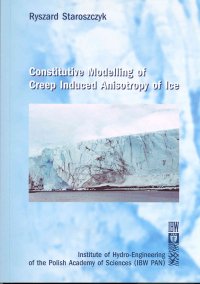
Instytut Budownictwa Wodnego
Polskiej Akademii Nauk
Polskiej Akademii Nauk



| ATTRIBUTE | VALUE |
|---|---|
| type | K |
| database id | 5417 |
| title | Constitutive modeling of creep induced anisotropy of ice |
| authors | Staroszczyk R.1 |
| affiliations | |
| year | 2004 |
| description | 201 s. (10 ark.) |
| ISBN | 8385708650 |
| publisher | Wydawnictwo IBW PAN |
| place | Gdańsk |
| cover |  |
| signatures | II25303, II25304, II25305, II25306, II25307 |
| abstracts | The book is devoted to the problem of constitutive modelling of creep induced anisotropy of ice which develops in the material as it is deformed during its movement from the free surface to depth in large polar ice sheets in Antarctica and Greenland. The evolution of the anisotropic structure of ice significantly changes macroscopic viscous properties of the medium and therefore affects the overall behaviour of polar ice caps. Three distinct methods are applied to formulate constitutive relations for ice. In the first method, microscopic flow laws are first derived for a single crystal of ice, and these are then used to determine the macroscopic creep response of the polycrystalline aggregate by averaging the responses of all constituent grains in the polycrystal. In the second approach, the microscopic flow laws for a single crystal are employed to construct the macroscopic constitutive relations by applying an orientation distribution function that describes directional properties of the medium. Finally, in the third method, the macroscopic constitutive laws are consistently derived as functions of only macroscopic variables. In the latter approach the evolution of the oriented structure in ice is described in terms of the changes in the principal directions in the macroscopic deformation field. All the proposed constitutive models are used to simulate the creep of anisotropic ice in simple flow configurations in order to correlate the model parameters with available experimental data. Finally, some of the models are employed to simulate the flow of large polar ice sheets. Książka poświęcona jest zagadnieniu modelowania konstytutywnego anizotropii lodu spowodowanej jego pełzaniem, która rozwija się w trakcie deformacji materiału podczas jego ruchu z powierzchni swobodnej w głąb wielkich lodowców polarnych na Antarktydzie i Grenlandii. Ewolucja struktury anizotropowej lodu znacząco zmienia makroskopowe własności lepkie ośrodka i dlatego ma duży wpływ na globalne zachowanie pokryw lodu polarnego. Zastosowano trzy różne metody formułowania związków konstytutywnych dla lodu. W pierwszej metodzie najpierw konstruuje się mikroskopowe prawa płynięcia dla pojedynczego kryształu lodu, a następnie, poprzez uśrednienie reakcji wszystkich kryształów w polikrysztale, wykorzystuje się je do wyznaczenia makroskopowej reakcji agregatu polikrystalicznego. W drugim podejściu, mikroskopowe prawa płynięcia dla pojedynczego kryształu są wykorzystywane do sformułowania makroskopowych związków konstytutywnych poprzez zastosowanie metody funkcji dystrybucji orientacji, przy pomocy której opisuje się zależność własności materialu od kierunku w przestrzeni. Na koniec, w trzeciej metodzie, makroskopowe prawa konstytutywne są formułowane w sposób konsekwentny jako funkcje wyłącznie zmiennych makroskopowych. W tym ostatnim podejściu ewolucja kierunków uprzywilejowanych w materiale jest opisana poprzez zmiany kierunków głównych makroskopowego pola deformacji. Wszystkie proponowane modele konstytutywne zostały zostosowane w symulacjach pełzania lodu w prostych konfiguracjach deformacji celem skorelowania parametrów modeli z dostępnymi danymi eksperymentalnymi. Na koniec, niektóre z modeli zastosowano do symulacji płynięcia wielkich lodowców polarnych. |
| attributes | [published] [reviewed] [scientific] [international reach] |
| language | en |
| points | 24 |